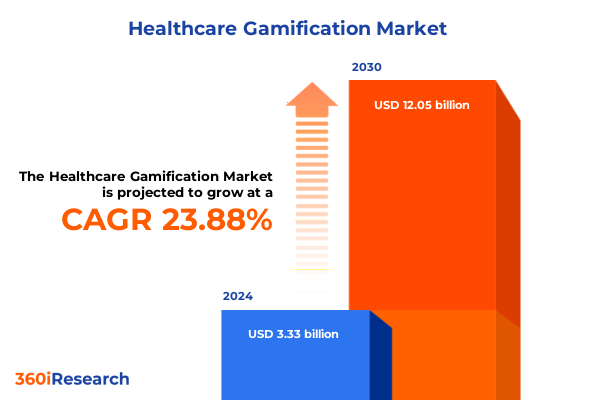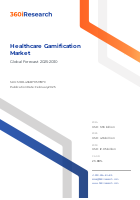The Healthcare Gamification Market size was estimated at USD 3.33 billion in 2024 and expected to reach USD 4.16 billion in 2025, at a CAGR 23.88% to reach USD 12.05 billion by 2030.

Introduction: A New Era in Healthcare Engagement
Healthcare gamification is emerging as a pivotal strategy that integrates technology and interactive design to transform patient engagement, professional training, and overall care outcomes. In this dynamic landscape, innovative approaches are harnessing the power of game mechanics to foster education, encourage proactive health management, and motivate behavioral change. The evolution of digital health solutions has set the stage for these interactive systems to become an essential element in both preventive and therapeutic care. This shift is driven by a combination of technological advancements, an increasing need for patient-centric care, and a desire to overcome traditional barriers in healthcare delivery.
As the industry adapts to rapidly changing patient preferences and expectations, stakeholders are exploring creative methodologies to integrate fun, competition, and rewards in everyday health activities. This transformation is not just a trend but a significant paradigm shift that improves engagement and enhances the overall quality of healthcare. Game-based applications now serve as a bridge between patient education and effective health management, ensuring that individuals stay informed and motivated. The promise of gamification in healthcare is underscored by its potential to influence behavioral outcomes and create more accessible and relevant care solutions.
With rising digital adoption among diverse user groups, this innovative phenomenon is paving the way for more interactive, data-driven, and user-friendly healthcare models. The intersection of technology and healthcare thus stands at a crossroads, inviting experts and industry leaders to reimagine the way care is delivered and experienced.
Transformative Shifts Reshaping the Healthcare Landscape
Recent years have witnessed profound changes that are reshaping the way healthcare is delivered and experienced. At the core of these transformative shifts is the increasing integration of gamification strategies across multiple touchpoints, from patient engagement to employee training. Evolving digital ecosystems have enabled seamless integration of game mechanics into the routines of healthcare systems, resulting in enhanced monitoring, personalized care experiences, and more effective interventions.
A key driver behind these changes has been the convergence of multidisciplinary innovations such as advanced data analytics, mobile technologies, and interactive design frameworks. This convergence has catalyzed a ripple effect, encouraging stakeholders to rethink traditional approaches while adopting agile, adaptable methods that align with the expectations of modern healthcare consumers. Interactive platforms that leverage realistic simulations, cognitive challenges, and competitive mechanics have not only improved patient adherence but have also empowered healthcare providers to deliver more value-driven solutions.
The transformation is further amplified by the adoption of tailored technologies that cater specifically to varied care settings. As a result, new business models and strategic partnerships are emerging, driving sustained growth and operational efficiencies. These developments underscore a broader evolution that is influencing every aspect of the healthcare value chain, paving the way for a new era where digital interactivity and healthcare delivery intersect in unprecedented ways.
Key Segmentation Insights Shaping Industry Strategies
The market segmentation analysis reveals a multifaceted landscape that is essential to navigating the complexities of healthcare gamification. Market dynamics have been dissected based on component, end-user, game type, application, and game mechanics. In component analysis, the market is scrutinized across device, service, and software. Device studies extend to Desktop and Laptops, Smartphones and Tablets, and Wearable Devices, emphasizing the shifting paradigms in user interaction. Service analysis includes evaluations spanning Consulting and Strategy, Integration and Implementation, and Support and Maintenance, showcasing the importance of comprehensive engagement strategies. Software is further analyzed for its potential to drive Data Analytics Solutions, Game Applications, and Software Development Platforms that are central to interactive health experiences.
The end-user segmentation further defines market potential by focusing on Healthcare Providers, Insurance Companies, and Patients. Sub-segments within Healthcare Providers, comprising Home Care Providers, Hospitals and Clinics, and Wellness Centers, emphasize varied operational scales and digital needs. Insurance Companies such as Accident Insurers, Health Insurers, and Life Insurers are increasingly harnessing game-based mechanisms to drive client engagement and risk management. Furthermore, the nuanced segmentation among Patients—highlighting needs in Chronic Disease Management, Lifestyle Management, and Preventive Health—indicates a tailored approach to behavioral health management.
Game type segmentation further differentiates interactive solutions into Puzzle and Strategy Games, Quiz-Based Games, and Simulation Games. Each game type offers specialized benefits including Cognitive Skill Development, Logic Puzzles, and Strategic Problem Solving, while also addressing health awareness and multiple choice challenges through quiz-based formats. Simulation Games further enrich patient and provider experiences with Scenario-Based and Virtual Reality Simulations. Additionally, the segmentation covering application explores the different use cases across Education and Training, Preventive, and Therapeutic arenas. Meanwhile, game mechanics, divided into Interactive and Adaptive Gameplay, Leaderboard Dynamics, and Point Scoring Systems, highlight the diversity in engagement models through adaptive difficulty levels, user feedback mechanics, competitive elements, and reward-based progress tracking. This detailed segmentation framework is instrumental in guiding targeted strategies and fostering innovation within the marketplace.
- Component
- End-User
- Game Type
- Application
- Game Mechanics
Regional Insights Across Key Global Markets
Regional insights within the healthcare gamification market illustrate significant growth and nuanced customer behavior across major global territories. In the Americas, advanced tech adoption and a robust innovation ecosystem drive high demand for digital health solutions, underpinning a transformation in patient management and provider engagement. Europe, Middle East & Africa collectively boast well-established healthcare systems that are increasingly integrating gamification to overcome operational challenges, enhance patient education, and boost preventive initiatives. Furthermore, in the Asia-Pacific region, rapid digital transformation, expanding mobile connectivity, and evolving consumer expectations are fueling market growth and setting the stage for a technology-first approach to healthcare delivery.
These regional distinctions underscore the importance of localized strategies that account for both cultural nuances and technological infrastructure, ensuring that gamified health solutions meet diverse market needs effectively.
- Americas
- Asia-Pacific
- Europe, Middle East & Africa
Key Company Insights and Competitive Dynamics
The competitive landscape in healthcare gamification is illustrated by a diverse array of companies that have strategically positioned themselves to lead and innovate in this burgeoning sector. Major players such as Akili Interactive Labs, Inc. and Ayogo Health, Inc. are pioneering digital health interventions that leverage cognitive science to drive enhanced patient engagement. Companies like Cardinal Health, Inc. and CogniFit Inc. complement these efforts with robust platforms that integrate comprehensive health solutions. Experion Technologies. and Fitbit, Inc. add a compelling blend of technology integration with lifestyle monitoring, further elevating the gamification experience.
In addition, Folio3 Software Inc. and higi SH LLC have made significant strides by developing adaptive gaming applications that merge medical expertise with interactive design. Hurix Systems Pvt. Ltd. and Koninklijke Philips N.V are at the forefront of bridging digital technology with traditional healthcare practices, while Mambo Solutions Ltd. and Microsoft Corporation continue to redefine the scope of digital health through multi-dimensional research and robust technological frameworks. Other notable companies including Omnicare, Oracle Corporation, Rally Health, Inc., and Strava, Inc. round out this competitive field by providing innovative solutions that focus on both patient needs and operational excellence. Supplementary contributions from SupperBetter, LLC, Under Armour, Inc., Virgin Pulse, and WeFitter further illustrate the rapid expansion and diversification of digital tools, driving a new era of comprehensive, interactive health management.
- Akili Interactive Labs, Inc.
- Ayogo Health, Inc.
- Cardinal Health, Inc.
- CogniFit Inc.
- Experion Technologies.
- Fitbit, Inc.
- Folio3 Software Inc.
- higi SH LLC
- Hurix Systems Pvt. Ltd.
- Koninklijke Philips N.V
- Mambo Solutions Ltd.
- Microsoft Corporation
- Omnicare
- Oracle Corporation
- Rally Health, Inc.
- Strava, Inc.
- SupperBetter, LLC
- Under Armour, Inc.
- Virgin Pulse
- WeFitter
Actionable Recommendations for Industry Leaders
Industry leaders must embrace a forward-thinking approach to harness the transformative potential of healthcare gamification. It is crucial to invest in advanced data analytics to continuously monitor and adapt interactive health solutions to evolving consumer needs and market conditions. By leveraging data-driven insights and predictive modeling, organizations can optimize user engagement platforms that deliver personalized experiences and improved clinical outcomes.
Furthermore, forming strategic alliances with technology innovators can catalyze the integration of cutting-edge gamification elements with existing healthcare delivery systems. Partnerships that combine expertise in digital transformation, usability design, and clinical validation are essential to develop robust solutions that excel in both performance and compliance. Industry leaders should also prioritize modular development strategies that facilitate rapid iterative improvements in product design, thus allowing for continual enhancements to user experience.
Additionally, companies are encouraged to adopt a holistic approach that spans across multiple segments and regions. Tailoring solutions that cater to distinct patient groups, healthcare environments, and technological infrastructures can significantly boost market competitiveness. Emphasizing user-centric design principles and investing in immersive technologies such as virtual and augmented reality further enrich the interactive experience. Ultimately, a strong focus on continuous innovation, customer education, and feedback will be pivotal in driving sustained growth and securing long-term success in this dynamic market.
Ask ResearchAI anything
World's First Innovative Al for Market Research
Conclusion: Strategic Imperatives for Future Growth
The evolution of healthcare gamification represents a fundamental shift toward more engaging and interactive digital health solutions that cater to both traditional and evolving consumer needs. The comprehensive analysis of current market segmentation, regional dynamics, and competitive insights reveals that effective gamification strategies can significantly enhance both patient engagement and provider efficiency. This detailed overview underlines the immense potential that lies in harnessing interactive technologies to drive proactive health management and innovative care delivery.
In light of these insights, the ongoing transition is clear: effective integration of game-based elements into healthcare is not merely a technological upgrade but a strategic imperative for achieving better outcomes. As the market continues to evolve, organizations that adopt these forward-looking strategies will not only secure a competitive advantage but also contribute meaningfully toward a more responsive, efficient, and patient-centered healthcare landscape.
- Preface
- Research Methodology
- Executive Summary
- Market Overview
- Market Insights
- Healthcare Gamification Market, by Component
- Healthcare Gamification Market, by End-User
- Healthcare Gamification Market, by Game Type
- Healthcare Gamification Market, by Application
- Healthcare Gamification Market, by Game Mechanics
- Americas Healthcare Gamification Market
- Asia-Pacific Healthcare Gamification Market
- Europe, Middle East & Africa Healthcare Gamification Market
- Competitive Landscape
- List of Figures [Total: 27]
- List of Tables [Total: 906 ]
Call-To-Action: Secure In-Depth Market Insights
For professionals seeking to translate these transformative trends into actionable business strategies, now is the time to gain a deeper understanding of the evolving landscape of healthcare gamification. Engage directly with Ketan Rohom, Associate Director, Sales & Marketing, to explore comprehensive reports that deliver detailed market analysis and valuable forecasting insights. These reports are designed to equip decision-makers with the data-driven intelligence needed to navigate this rapidly changing ecosystem. Explore the in-depth findings and strategic recommendations to secure your organization’s competitive edge in this vibrant market. Reach out today to access the full market analysis and underpin your next strategic move with robust, actionable intelligence.

- How big is the Healthcare Gamification Market?
- What is the Healthcare Gamification Market growth?
- When do I get the report?
- In what format does this report get delivered to me?
- How long has 360iResearch been around?
- What if I have a question about your reports?
- Can I share this report with my team?
- Can I use your research in my presentation?




